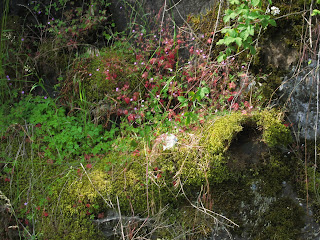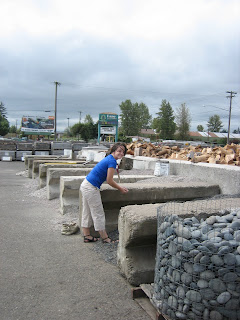
The following are a series of images of naturally created and intentionally cultivated moss walls. They represent an array of possibilities and potential that sparked our interests early on in the conceptual development phase. We are interested in the application of moss walls both for interior as well as exterior environments, both as a visual design feature and a tactile element that encourages interaction with the spaces we inhabit. In addition to being aesthetically pleasing, we intend to explore possible subsequent benefits from the micro-climates and cooling effects created by moss cultivation within our living environments.
















To begin the project we used the natural environment as our catalyst. We embarked on a walking tour of The University of Oregon campus and outlying areas collecting moss that we found growing in the cool shadows. We found the most variety of species growing on the north stone face of Hendricks Hill along Franklin Boulevard. We also found several ferns and flowers that were growing within the moss with almost no soil. Our intent is to identify the different type of mosses and determine which would be the most suitable for propagation within a constructed environment. We also noted the coloration, size, and texture each species offered and their potential to mosaic together as in some of the precedents we had looked at earlier. We took the samples back to studio and let portions go dormant and dry while other portions we kept in cups with water to see how each species looked in both conditions. Eventually, the moss species that we determine to be the most suitable for our moss wall project will be put in a blender with buttermilk to begin the propagation process and applied like a paint to test-rocks for display.















After gathering our moss, we went to Willamette Graystone and Lane Forest Products to collect stone samples for mediums on which to grow the moss. We collected a variety of natural and constructed stone types from bricks and pavers to river rocks and slate to see what surfaces will grow moss and which, of them, work the best.











With all of our materials gathered we had to consider how we were going to mount and display our samples. We chose to create form-work that would fit in between the ribs of the storage container were we will eventually be displaying our work. Our plan was to make five different forms, with each of them being divided into four separate horizontal chambers. Each chamber will be filled with concrete and embedded with the same stone sample. However, each horizontal portion will be painted with a different species of moss sample. In this way we will be able to see how different moss species react to different types of stone as a growing medium. We used The University of Oregon Craft Center, the AAA Woodshop, and our personal shop space as well as the site itself for construction.
















The moss wall headboard precedent is very weird. I like it though. I am excited to see what you two brew up over the next couple of weeks.
ReplyDeleteYou two know how much i love this project, and I look forward to seeing it grow over two years at the courthouse. I also think you are establishig an important protocol for architects to remember, RESEARCH!!! You work is a essentially a continuum from Bryotec and the lichen wall designed by CMG and the SF MOMA. The specification of moss covered surfaces is well suited to dense urban environments, and if you where to continue this type of work you may find an interesting niche, literally! It is very interesting to see your process and exploration documented so well, and I beleive that just seeing this project come together is a valuable contribution to this class and future work!! Great work!
ReplyDeleteI also want to commend your craftsmanship, response to site conditions, and positive work ethic! You two have owned this project since day one, and it is exciting that the final design is still evolving..
ReplyDeleteI seriously cant wait to do some moss grafitti with the pigmented buttermilk!!!!!!!1
dum
ReplyDeleteit is spelled "dumb"
DeleteHey great work! I hope to see some more about the growth of the project.
ReplyDeletethx! robert
The science of soil-less gardening is called hydroponics. It basically involves growing healthy plants without the use of a traditional hydroponics nutrients soil medium by using a nutrient like a mineral rich water solution instead. A plant just needs select nutrients, some water, and sunlight to grow.
ReplyDelete